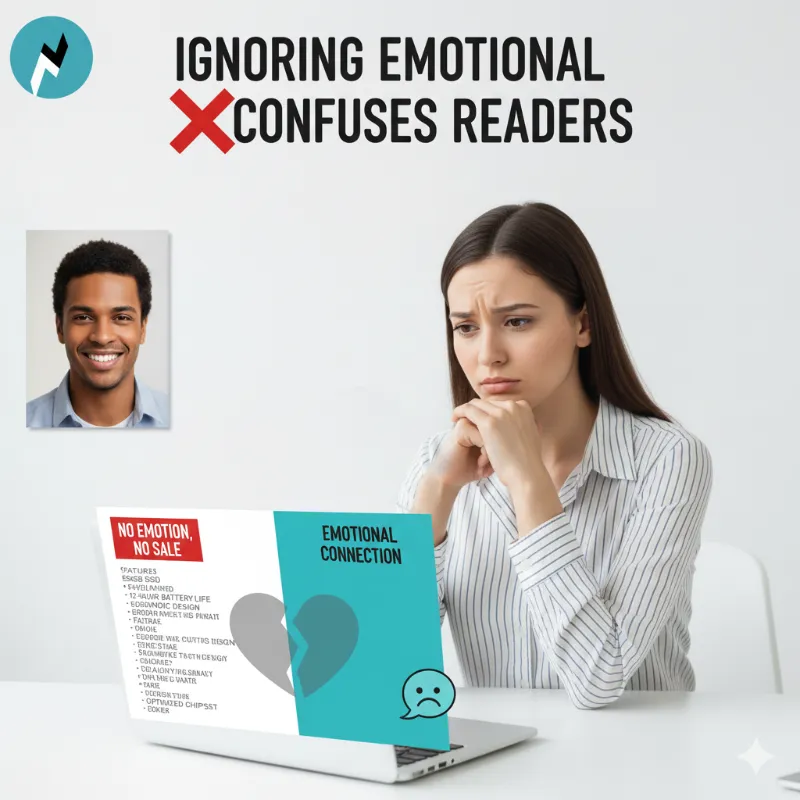Copywriting Mistakes That Are Killing Your Conversions | How to Fix Them
Published: 26 Oct 2025
Most businesses lose sales because of simple copywriting mistakes. Your message might be perfect, but small errors push customers away. Studies show that 70% of website copy fails to convert visitors into buyers.
This guide reveals the most common copywriting mistakes and shows you exactly how to fix them. Let’s dive in.
1. Writing About Yourself Instead of Your Customer
Many writers make everything about their company. They write “we offer” and “our company provides” instead of focusing on customer needs. This is writing that’s all about “me” and it pushes readers away.
Not writing for your audience creates a disconnect. Customers want solutions, not company history.
Bad Example: “We are an award-winning company with 20 years of experience in software development.”
Good Example: “You’ll save 10 hours every week with our simple project management tool.”

How to Fix It
Use audience-centered writing techniques. Follow the “you” vs. “we” ratio test. Use “you” three times more than “we.”
Start sentences with “you” and “your.” Focus on benefits, not features. Ask yourself: “What does this mean for my reader?”
This simple shift transforms content copywriting mistakes into engaging copy that converts.
2. Using Passive Voice
Using passive voice in copywriting makes sentences weak and confusing. It creates distance between your message and readers.
Passive: “The order will be processed by our team.” Active: “Our team will process your order.”
See the difference? Active voice feels direct and honest. Copywriting that doesn’t engage readers often relies on passive constructions.
How to Fix It
Learn how to write active voice sentences. Follow this pattern: subject + verb + object.
Use the Hemingway editor readability score to find passive voice in your writing. This tool highlights problem areas in green.
Replace “was done by” with clear action words. Make your sentences strong and direct. This improves readability in copywriting instantly.
3. Drowning in Jargon and Buzzwords
Overusing industry jargon confuses readers. Buzzwords in marketing copy sound fake and create messaging that fails to connect with the audience.
When you write “synergistic solutions” or “best-in-class platforms,” most people don’t understand you. This lack of clarity in content writing costs sales.
How to Fix It
Learn how to write without jargon. Use the “explain it to a 10-year-old” test. If a child can’t understand it, simplify it.
Replace complex terms with simple words:
- “Utilize” becomes “use”
- “Facilitate” becomes “help”
- “Implement” becomes “start”
Use Grammarly copywriting tips to check your readability level. Aim for an 8th-grade reading level or lower. This makes your copy accessible to everyone.

4. Adding Too Much Fluff
Too much fluff in copywriting wastes time. Filler words in marketing copy dilute your message and create a boring or generic writing style.
Words like “really,” “very,” “just,” and “actually” add nothing. They make sentences longer without adding value.
Fluffy: “It’s really very important to actually consider that our solution can basically help you.” Clear: “Our solution helps you save time.”
How to Fix It
Learn how to avoid fluff in your writing. Cut every unnecessary word. Ask: “Does this word add meaning?”
Delete these common fillers:
- Really, very, quite
- Just, actually, basically
- To (use “to”)
- At this point in time (use “now”)
Use the Hemingway App to identify dense sentences. Edit until your message is crystal clear. This is essential for improving the readability score.
5. Writing Like a Robot
Non-conversational copywriting feels cold. When copy sounds corporate and stiff, it creates sales copywriting mistakes that hurt conversions.
Nobody talks like this: “We utilize innovative methodologies to facilitate optimal outcomes.” This writing, without an emotional connection, fails to persuade.
How to Fix It
Learn how to write conversational copy. Write like you talk. Use contractions like “you’re,” “don’t,” and “it’s.”
Read your copy aloud. If it sounds weird, rewrite it. This is the best test for tone of voice in copywriting.
Ask questions in your copy. Use short sentences. Start some sentences with “And” or “But.” This creates natural rhythm and helps with fixing poor messaging in content writing.
6. Creating Weak Headlines
Bad headlines kill good content. When headlines don’t grab attention, nobody reads your copy. This is where website copywriting errors start.
Generic headlines like “Our Services” or “Welcome” waste space. They miss emotional triggers in marketing copy that make people click.
How to Fix It
Master writing headlines that attract readers. Use these proven formulas:
Numbers: “7 Ways to Double Your Sales”
Questions: “Are You Making These Copywriting Mistakes?”
Benefits: “Save 10 Hours Every Week”
Curiosity: “The One Thing Killing Your Conversions”
Practice optimizing headlines for SEO while keeping them engaging. Include your main keyword near the beginning. Test different versions using A/B testing for copywriting.
7. Ignoring Emotional Connection
Writing without emotional connection is one of the biggest reasons why your copywriting isn’t converting. Facts make people think. Emotions make them buy.
Copy that only lists features misses the power of storytelling in copywriting. People remember stories and feelings, not specifications.
How to Fix It
Learn how to write copy that connects emotionally. Understand your audience’s pain points deeply. What keeps them awake at night?
Use engaging storytelling in content. Share customer success stories. Paint pictures with your words.
Logical: “Our software has 256-bit encryption.”
Emotional: “Sleep soundly knowing your data is completely safe.”

8. Poor Formatting and Layout
Poorly formatted blog posts drive readers away instantly. Wall-of-text syndrome makes even great content look hard to read.
When you don’t use effective content structure, people bounce. Mobile users especially need scannable content.
How to Fix It
Break up your text. Use these formatting rules:
- Keep paragraphs to 2-3 sentences
- Add subheadings every 200-300 words
- Use bullet points for lists
- Add white space generously
- Bold important phrases
Creating people-first content means making it easy to consume. Short paragraphs improve readability in copywriting by 60%.
Use descriptive subheadings that tell readers what each section covers. This helps them scan and find what matters most.
9. Never Testing Your Copy
Not testing your content performance is a critical mistake. How do you know what works if you don’t measure results?
Many businesses guess what their audience wants. These guesses are often wrong. This wastes time and money on conversion copywriting that doesn’t convert.
How to Fix It
Understand the importance of copy testing. Test one element at a time:
Test headlines first. They have the biggest impact. Try different approaches and measure clicks.
Test calls to action. Change button text. “Get Started Free” might beat “Sign Up” by 30%.
Test email subject lines. Small changes make big differences.
Use A/B testing for copywriting tools. Run tests for at least two weeks to get reliable data. Document what works.
10. Forgetting About SEO
Great copy that nobody finds is useless. Many writers ignore copywriting for SEO basics. They create excellent content that never ranks.
Others stuff keywords awkwardly. This ruins readability while trying to please search engines. Missing copywriting for content marketing opportunities costs traffic.
How to Fix It
Balance SEO with quality. Learn how to write engaging website copy that ranks well.
Follow these copywriting tips for SEO optimize content:
Include target keywords naturally: Place them in headlines, the first paragraph, and throughout the content. Don’t force them.
Write for humans first: Search engines now reward content that helps people. Creating people-first content is the best SEO strategy.
Use related terms: Include LSI keywords naturally. This signals topic relevance to Google.
Optimize meta descriptions: Write compelling descriptions that include your main keyword.
11. Ignoring Mobile Readers
Over 60% of web traffic comes from mobile devices. Yet many writers create copy that looks terrible on phones. Long paragraphs become walls of text. Small fonts strain eyes. Buttons are hard to tap.
This creates poorly formatted blog posts that mobile users abandon immediately. They bounce within seconds because reading feels like work.
How to Fix It
Write with mobile-first thinking. Keep paragraphs to 1-2 sentences on mobile. Use larger font sizes (at least 16px). Make buttons big enough to tap easily.
Test your copy on your phone before publishing. Does it look clean? Can you read it without zooming? If not, rewrite it.
Add more white space between sections. Break up long sentences. Use bullet points generously. This improves readability in copywriting for all devices.
Quick Check: Open your website on your phone right now. Can you read everything easily? That’s your answer.
12. Missing Clear Call-to-Action
Readers finish your content but don’t know what to do next. No clear direction means no conversions. This is a critical sales copywriting mistake.
Weak CTAs like “Click Here” or “Learn More” don’t motivate action. They’re vague and boring. Readers skip them completely.
Some content has no CTA at all. Writers assume readers will figure out the next step. They won’t. You must guide them.
How to Fix It
Add strong, specific CTAs throughout your content. Tell readers exactly what to do and why they should do it.
Weak CTA: “Download Now”
Strong CTA: “Download Your Free Checklist—Start Fixing These Mistakes Today”
Use action verbs that create urgency:
- “Start Your Free Trial”
- “Get Instant Access”
- “Claim Your Discount”
13. Writing Too Long (or Too Short)
Length matters in copywriting for content marketing. Too long, and readers lose interest. Too short, and you don’t build enough trust or provide enough value.
Many writers add fluff to hit word counts. Others cut corners and leave readers with questions. Both approaches hurt conversion copywriting.
The wrong length for your audience creates frustration. Blog readers want depth. Social media users want brevity. Landing page visitors want focused information.
How to Fix It
Match your content length to the reader’s intent and the platform. Ask: “What does my audience need here?”
- Blog Posts: 1,500-2,500 words for informational content,
- Landing Pages: 500-1,000 words focused on one action
- Email Copy: 50-200 words that get to the point, Social Media: 50-100 words maximum
14. Copying Competitors Blindly
Many businesses copy what competitors write. They use the same phrases, structure, and style. This creates generic content that blends into the background.
When everyone sounds the same, nobody stands out. Your boring or generic writing style makes you forgettable. Readers can’t tell your brand from dozens of others.
Copying also means you inherit your competitors’ copywriting mistakes. Maybe their approach doesn’t even work. You’re copying failure, not success.
How to Fix It
Develop your unique tone of voice in copywriting. Study competitors but don’t copy them. Find what makes your brand different.
Ask these questions:
- What do we believe that competitors don’t?
- How do we solve problems differently?
- What personality should our brand have?
Use persuasive brand messaging that reflects your actual values. If you’re fun and casual, write that way. If you’re serious and professional, own it.
Share your real stories and experiences. Nobody else has your exact perspective. This creates an authentic connection and helps with building trust with copywriting.
15. Not Knowing Your Audience
This is the foundation of all copywriting errors to avoid. When you do not understand your audience, everything else fails.
Writers guess what readers want. They assume everyone thinks like they do. This leads to not writing for your audience and missing what actually matters to them.
Generic targeting like “everyone who needs our product” doesn’t work. You can’t write compelling copy for “everyone.” Different people have different understandings of audience pain points, motivations, and objections.
How to Fix It
Research your audience deeply before writing anything. Create detailed buyer personas that include:
Demographics: Age, location, job title, income
Psychographics: Goals, fears, values, challenges
Behavior: Where they search for information, what influences them.
Interview real customers. Ask:
- What problem were you trying to solve?
- What almost stopped you from buying?
- How would you describe our product to a friend?
Quick Fixes: Copywriting Do’s and Don’ts
Following these copywriting do’s and don’ts gives you a framework for ways to avoid common copywriting errors in everything you write.
| Do This |
|---|
|
| Don’t Do This |
|---|
|
Take Action Now
You now know the 15 biggest copywriting mistakes that hurt your conversions. The solution is simple: test, refine, and improve constantly.
Start small. Pick one mistake from this guide. Fix it today. Test the results. Then move to the next one.
Download our free copywriting mistakes checklist to track your progress. It gives you quick fixes for each mistake.
Remember: great copy isn’t about perfection. It’s about understanding your audience and speaking directly to their needs.
Your next step: Audit your homepage right now. Find one mistake and fix it this week. That’s how you transform your copy and boost conversions—one improvement at a time.

- Be Respectful
- Stay Relevant
- Stay Positive
- True Feedback
- Encourage Discussion
- Avoid Spamming
- No Fake News
- Don't Copy-Paste
- No Personal Attacks

- Be Respectful
- Stay Relevant
- Stay Positive
- True Feedback
- Encourage Discussion
- Avoid Spamming
- No Fake News
- Don't Copy-Paste
- No Personal Attacks





